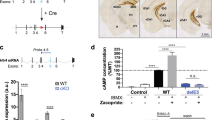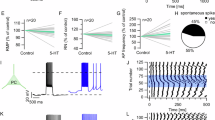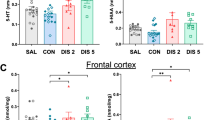Abstract
Serotonin (5-HT) and the serotonergic system have recently been indicated as modulators of adult hippocampal neurogenesis. In this study, we evaluated the role of 5-HT on the functional features in neurospheres derived from adult neural stem cells (ANSC). We cultured neurospheres derived from mouse hippocampus in serum-free medium containing epidermal (EGF) and type-2 fibroblast growth factor (FGF2). Under these conditions ANSC expressed both isoforms of tryptophane-hydroxylase (TPH) and produced 5-HT. Blocking TPH function by para-chlorophenylalanine (PCPA) reduced ANSC proliferation, which was rescued by exogenous 5-HT. 5-HT action on ANSC was mediated predominantly by the serotonin receptor subtype 5-HT1A and, to a lesser extent, through the 5-HT2C (receptor) subtype, as shown by selectively antagonizing these receptors. Finally, we documented a 5-HT-induced increase of ANSC migration activity. In summary, we demonstrated a powerful serotonergic impact on ANSC functional features, which was mainly mediated by 5-HT1A receptors.
Similar content being viewed by others
Log in or create a free account to read this content
Gain free access to this article, as well as selected content from this journal and more on nature.com
or
References
Alvarez-Buylla A, Seri B, Doetsch F (2002). Identification of neural stem cells in the adult vertebrate brain. Brain Res Bull 57: 751–758.
Banasr M, Hery M, Printemps R, Daszuta A (2004). Serotonin-induced increases in adult cell proliferation and neurogenesis are mediated through different and common 5-HT receptor subtypes in the dentate gyrus and the subventricular zone. Neuropsychopharmacology 29: 450–460.
Barnes NM, Sharp T (1999). A review of central 5-HT receptors and their function. Neuropharmacology 38: 1083–1152.
Benoit BO, Savarese T, Joly M, Engstrom CM, Pang L, Reilly J et al (2001). Neurotrophin channeling of neural progenitor cell differentiation. J Neurobiol 46: 265–280.
Blier P, Ward NM (2003). Is there a role for 5-HT1A agonists in the treatment of depression? Biol Psychiatry 53: 193–203.
Borta A, Hoglinger GU (2007). Dopamine and adult neurogenesis. J Neurochem 100: 587–595.
Brezun JM, Daszuta A (1999). Depletion in serotonin decreases neurogenesis in the dentate gyrus and the subventricular zone of adult rats. Neuroscience 89: 999–1002.
Brezun JM, Daszuta A (2000a). Serotonergic reinnervation reverses lesion-induced decreases in PSA-NCAM labeling and proliferation of hippocampal cells in adult rats. Hippocampus 10: 37–46.
Brezun JM, Daszuta A (2000b). Serotonin may stimulate granule cell proliferation in the adult hippocampus, as observed in rats grafted with foetal raphe neurons. Eur J Neurosci 12: 391–396.
Cameron HA, McEwen BS, Gould E (1995). Regulation of adult neurogenesis by excitatory input and NMDA receptor activation in the dentate gyrus. J Neurosci 15: 4687–4692.
Corti S, Locatelli F, Papadimitriou D, Donadoni C, Del Bo R, Fortunato F et al (2005). Multipotentiality, homing properties, and pyramidal neurogenesis of CNS-derived LeX(ssea-1)+/CXCR4+ stem cells. FASEB J 19: 1860–1862.
Doetsch F, Petreanu L, Caille I, Garcia-Verdugo JM, Alvarez-Buylla A (2002). EGF converts transit-amplifying neurogenic precursors in the adult brain into multipotent stem cells. Neuron 36: 1021–1034.
Dranovsky A, Hen R (2006). Hippocampal neurogenesis: regulation by stress and antidepressants. Biol Psychiatry 59: 1136–1143.
Encinas JM, Vaahtokari A, Enikolopov G (2006). Fluoxetine targets early progenitor cells in the adult brain. Proc Natl Acad Sci USA 103: 8233–8238.
Gage FH (2000). Mammalian neural stem cells. Science 287: 1433–1438.
Gage FH, Kempermann G, Palmer TD, Peterson DA, Ray J (1998). Multipotent progenitor cells in the adult dentate gyrus. J Neurobiol 36: 249–266.
Gardier AM, David DJ, Jego G, Przybylski C, Jacquot C, Durier S et al (2003). Effects of chronic paroxetine treatment on dialysate serotonin in 5-HT1B receptor knockout mice. J Neurochem 86: 13–24.
Gould E (1999). Serotonin and hippocampal neurogenesis. Neuropsychopharmacology 21: 46S–51S.
Gould E, Cameron HA (1997). Early NMDA receptor blockade impairs defensive behavior and increases cell proliferation in the dentate gyrus of developing rats. Behav Neurosci 111: 49–56.
Gozlan H, Thibault S, Laporte AM, Lima L, Hamon M (1995). The selective 5-HT1A antagonist radioligand [3H]WAY 100635 labels both G-protein-coupled and free 5-HT1A receptors in rat brain membranes. Eur J Pharmacol 288: 173–186.
Gritti A, Cova L, Parati EA, Galli R, Vescovi AL (1995). Basic fibroblast growth factor supports the proliferation of epidermal growth factor-generated neuronal precursor cells of the adult mouse CNS. Neurosci Lett 185: 151–154.
Gritti A, Frolichsthal-Schoeller P, Galli R, Parati EA, Cova L, Pagano SF et al (1999). Epidermal and fibroblast growth factors behave as mitogenic regulators for a single multipotent stem cell-like population from the subventricular region of the adult mouse forebrain. J Neurosci 19: 3287–3297.
Gritti A, Parati EA, Cova L, Frolichsthal P, Galli R, Wanke E et al (1996). Multipotential stem cells from the adult mouse brain proliferate and self-renew in response to basic fibroblast growth factor. J Neurosci 16: 1091–1100.
Gritti A, Rosati B, Lecchi M, Vescovi AL, Wanke E (2000). Excitable properties in astrocytes derived from human embryonic CNS stem cells. Eur J Neurosci 12: 3549–3559.
Gritti A, Vescovi AL, Galli R (2002). Adult neural stem cells: plasticity and developmental potential. J Physiol Paris 96: 81–90.
Gross RE, Mehler MF, Mabie PC, Zang Z, Santschi L, Kessler JA (1996). Bone morphogenetic proteins promote astroglial lineage commitment by mammalian subventricular zone progenitor cells. Neuron 17: 595–606.
Gutknecht L, Kriegebaum C, Waider J, Schmitt A, Lesch KP (2009). Spatio-temporal expression of tryptophan hydroxylase isoforms in murine and human brain: Convergent data from Tph2 knockout mice. Eur Neuropsychopharmacol 19: 266–282.
Gutknecht L, Waider J, Kraft S, Kriegebaum C, Holtmann B, Reif A et al (2008). Deficiency of brain 5-HT synthesis but serotonergic neuron formation in Tph2 knockout mice. J Neural Transm 115: 1127–1132.
Hamon M, Gozlan H, el Mestikawy S, Emerit MB, Bolanos F, Schechter L (1990). The central 5-HT1A receptors: pharmacological, biochemical, functional, and regulatory properties. Ann NY Acad Sci 600: 114–129; discussion 129–131.
Hoglinger GU, Rizk P, Muriel MP, Duyckaerts C, Oertel WH, Caille I et al (2004). Dopamine depletion impairs precursor cell proliferation in Parkinson disease. Nat Neurosci 7: 726–735.
Huang GJ, Herbert J (2005). The role of 5-HT1A receptors in the proliferation and survival of progenitor cells in the dentate gyrus of the adult hippocampus and their regulation by corticoids. Neuroscience 135: 803–813.
Hurley JH, Zhang S, Bye LS, Marshall MS, DePaoli-Roach AA, Guan K et al (2003). Insulin signaling inhibits the 5-HT2C receptor in choroid plexus via MAP kinase. BMC Neurosci 4: 10.
Ikegami T, Nakamura M, Yamane J, Katoh H, Okada S, Iwanami A et al (2005). Chondroitinase ABC combined with neural stem/progenitor cell transplantation enhances graft cell migration and outgrowth of growth-associated protein-43-positive fibers after rat spinal cord injury. Eur J Neurosci 22: 3036–3046.
Jacobs BL, Praag H, Gage FH (2000). Adult brain neurogenesis and psychiatry: a novel theory of depression. Mol Psychiatry 5: 262–269.
Jagasia R, Song H, Gage FH, Lie DC (2006). New regulators in adult neurogenesis and their potential role for repair. Trends Mol Med 12: 400–405.
Kawano H, Tsuji H, Nishimura H, Kimura S, Yano S, Ukimura N et al (2001). Serotonin induces the expression of tissue factor and plasminogen activator inhibitor-1 in cultured rat aortic endothelial cells. Blood 97: 1697–1702.
Kempermann G, Kronenberg G (2003). Depressed new neurons—adult hippocampal neurogenesis and a cellular plasticity hypothesis of major depression. Biol Psychiatry 54: 499–503.
Kippin TE, Kapur S, van der Kooy D (2005). Dopamine specifically inhibits forebrain neural stem cell proliferation, suggesting a novel effect of antipsychotic drugs. J Neurosci 25: 5815–5823.
Koe BK (1971). Tryptophan hydroxylase inhibitors. Fed Proc 30: 886–896.
Kuhn HG, Winkler J, Kempermann G, Thal LJ, Gage FH (1997). Epidermal growth factor and fibroblast growth factor-2 have different effects on neural progenitors in the adult rat brain. J Neurosci 17: 5820–5829.
Lesch KP, Mossner R (1999). Knockout Corner: 5-HT(1A) receptor inactivation: anxiety or depression as a murine experience. Int J Neuropsychopharmacol 2: 327–331.
Li Y, Luikart BW, Birnbaum S, Chen J, Kwon CH, Kernie SG et al (2008). TrkB regulates hippocampal neurogenesis and governs sensitivity to antidepressive treatment. Neuron 59: 399–412.
Lie DC, Colamarino SA, Song HJ, Desire L, Mira H, Consiglio A et al (2005). Wnt signalling regulates adult hippocampal neurogenesis. Nature 437: 1370–1375.
Malberg JE, Eisch AJ, Nestler EJ, Duman RS (2000). Chronic antidepressant treatment increases neurogenesis in adult rat hippocampus. J Neurosci 20: 9104–9110.
Ming GL, Song H (2005). Adult neurogenesis in the mammalian central nervous system. Annu Rev Neurosci 28: 223–250.
Nacher J, McEwen BS (2006). The role of N-methyl-D-asparate receptors in neurogenesis. Hippocampus 16: 267–270.
Nebigil CG, Etienne N, Messaddeq N, Maroteaux L (2003). Serotonin is a novel survival factor of cardiomyocytes: mitochondria as a target of 5-HT2B receptor signaling. FASEB J 17: 1373–1375.
Nebigil CG, Maroteaux L (2001). A novel role for serotonin in heart. Trends Cardiovasc Med 11: 329–335.
Patel PD, Pontrello C, Burke S (2004). Robust and tissue-specific expression of TPH2 vs TPH1 in rat raphe and pineal gland. Biol Psychiatry 55: 428–433.
Prestoz L, Relvas JB, Hopkins K, Patel S, Sowinski P, Price J et al (2001). Association between integrin-dependent migration capacity of neural stem cells in vitro and anatomical repair following transplantation. Mol Cell Neurosci 18: 473–484.
Radley JJ, Jacobs BL (2002). 5-HT1A receptor antagonist administration decreases cell proliferation in the dentate gyrus. Brain Res 955: 264–267.
Reynolds BA, Rietze RL (2005). Neural stem cells and neurospheres—re-evaluating the relationship. Nat Methods 2: 333–336.
Reynolds BA, Weiss S (1992). Generation of neurons and astrocytes from isolated cells of the adult mammalian central nervous system. Science 255: 1707–1710.
Richard F, Sanne JL, Bourde O, Weissman D, Ehret M, Cash C et al (1990). Variation of tryptophan-5-hydroxylase concentration in the rat raphe dorsalis nucleus after p-chlorophenylalanine administration. I. A model to study the turnover of the enzymatic protein. Brain Res 536: 41–45.
Sakowski SA, Geddes TJ, Thomas DM, Levi E, Hatfield JS, Kuhn DM (2006). Differential tissue distribution of tryptophan hydroxylase isoforms 1 and 2 as revealed with monospecific antibodies. Brain Res 1085: 11–18.
Santa-Olalla J, Baizabal JM, Fregoso M, del Carmen Cardenas M, Covarrubias L (2003). The in vivo positional identity gene expression code is not preserved in neural stem cells grown in culture. Eur J Neurosci 18: 1073–1084.
Santarelli L, Saxe M, Gross C, Surget A, Battaglia F, Dulawa S et al (2003). Requirement of hippocampal neurogenesis for the behavioral effects of antidepressants. Science 301: 805–809.
Saviozzi S, Cordero F, Lo Iacono M, Novello S, Scagliotti GV, Calogero RA (2006). Selection of suitable reference genes for accurate normalization of gene expression profile studies in non-small cell lung cancer. BMC Cancer 6: 200.
Schmitt A, Benninghoff J, Moessner R, Rizzi M, Paizanis E, Doenitz C et al (2007). Adult neurogenesis in serotonin transporter deficient mice. J Neural Transm 114: 1107–1119.
Seki T (2002). Hippocampal adult neurogenesis occurs in a microenvironment provided by PSA-NCAM-expressing immature neurons. J Neurosci Res 69: 772–783.
Seri B, Herrera DG, Gritti A, Ferron S, Collado L, Vescovi A et al (2006). Composition and organization of the SCZ: a large germinal layer containing neural stem cells in the adult mammalian brain. Cereb Cortex 16 (Suppl 1): i103–i111.
Shan X, Chi L, Bishop M, Luo C, Lien L, Zhang Z et al (2006). Enhanced de novo neurogenesis and dopaminergic neurogenesis in the substantia nigra of 1-methyl-4-phenyl-1,2,3,6-tetrahydropyridine-induced Parkinson's disease-like mice. Stem Cells 24: 1280–1287.
Tropepe V, Craig CG, Morshead CM, van der Kooy D (1997). Transforming growth factor-alpha null and senescent mice show decreased neural progenitor cell proliferation in the forebrain subependyma. J Neurosci 17: 7850–7859.
Varrault A, Bockaert J, Waeber C (1992a). Activation of 5-HT1A receptors expressed in NIH-3T3 cells induces focus formation and potentiates EGF effect on DNA synthesis. Mol Biol Cell 3: 961–969.
Varrault A, Journot L, Audigier Y, Bockaert J (1992b). Transfection of human 5-hydroxytryptamine1A receptors in NIH-3T3 fibroblasts: effects of increasing receptor density on the coupling of 5-hydroxytryptamine1A receptors to adenylyl cyclase. Mol Pharmacol 41: 999–1007.
Vogel C, Mossner R, Gerlach M, Heinemann T, Murphy DL, Riederer P et al (2003). Absence of thermal hyperalgesia in serotonin transporter-deficient mice. J Neurosci 23: 708–715.
Wacker MJ, Godard MP (2005). Analysis of one-step and two-step real-time RT-PCR using SuperScript III. J Biomol Tech 16: 266–271.
Walther DJ, Bader M (1999). Serotonin synthesis in murine embryonic stem cells. Brain Res Mol Brain Res 68: 55–63.
Walther DJ, Bader M (2003). A unique central tryptophan hydroxylase isoform. Biochem Pharmacol 66: 1673–1680.
Warner-Schmidt JL, Duman RS (2006). Hippocampal neurogenesis: opposing effects of stress and antidepressant treatment. Hippocampus 16: 239–249.
Weickert CS, Blum M (1995). Striatal TGF-alpha: postnatal developmental expression and evidence for a role in the proliferation of subependymal cells. Brain Res Dev Brain Res 86: 203–216.
Zill P, Buttner A, Eisenmenger W, Muller J, Moller HJ, Bondy B (2009). Predominant expression of tryptophan hydroxylase 1 mRNA in the pituitary: a postmortem study in human brain. Neuroscience 159: 1274–1282.
Acknowledgements
We thank Tatiana Veneroso and Alberto Visioli for their excellent technical support. We express our gratitude to Donald Kuhn, Wayne State University, and to Dennis Murphy, NIMH, NIH, for providing essential antisera and chemical compounds for our experiments. We are particularly indebted to Roberta Palumbo for teaching how to do Boyden chamber experiments. A final thanks to Kent Hufford for his critical reading of the paper.
Author information
Authors and Affiliations
Corresponding author
Additional information
This work is dedicated to Helmut Beckmann, the former chair of the Department of Psychiatry at the University of Wuerzburg
DISCLOSURE
This work was supported by Deutsche Forschungsgemeinschaft (DFG) Be2530 to JB, Förderprogramm Forschung und Lehre (FöFoLe) of University of Munich to JB, and SFB 531 to JB/KPL. None of the authors declare any conflict of interest.
Rights and permissions
About this article
Cite this article
Benninghoff, J., Gritti, A., Rizzi, M. et al. Serotonin Depletion Hampers Survival and Proliferation in Neurospheres Derived from Adult Neural Stem Cells. Neuropsychopharmacol 35, 893–903 (2010). https://doi.org/10.1038/npp.2009.181
Received:
Revised:
Accepted:
Published:
Issue date:
DOI: https://doi.org/10.1038/npp.2009.181
Keywords
This article is cited by
-
Cannabidiol Exerts Sedative and Hypnotic Effects in Normal and Insomnia Model Mice Through Activation of 5-HT1A Receptor
Neurochemical Research (2024)
-
Trehalose as glucose surrogate in proliferation and cellular mobility of adult neural progenitor cells derived from mouse hippocampus
Journal of Neural Transmission (2019)
-
In vivo relationship between serotonin 1A receptor binding and gray matter volume in the healthy brain and in major depressive disorder
Brain Structure and Function (2018)
-
Control of adult neurogenesis by programmed cell death in the mammalian brain
Molecular Brain (2016)
-
5-HT2 receptors mediate functional modulation of GABAa receptors and inhibitory synaptic transmissions in human iPS-derived neurons
Scientific Reports (2016)



